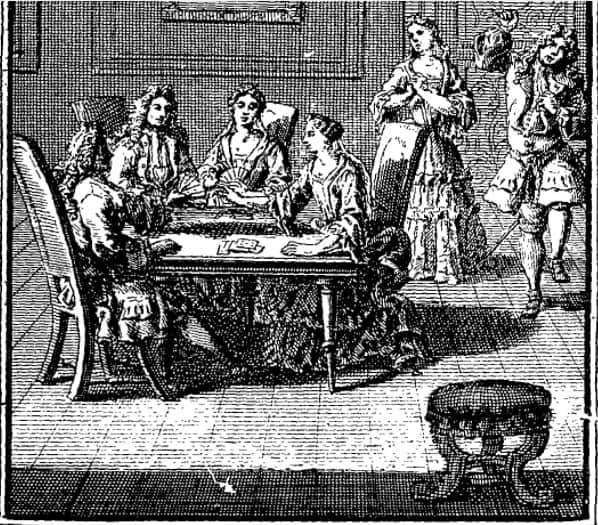By Daniel Mercieca, Gale Ambassador at Durham University
‘Since t’is the intent and business of the stage,
To copy out the follies of the age
To hold to every man a glass,
And show him of what species he’s an ass’.[1]
– John Vanbrugh
The sharp, epigrammatic wit of John Vanbrugh’s preface to The Provoked Wife (1697), reflects the theatricality of eighteenth-century audiences and exposes the wider hypocrisy of the ‘Public Sphere’[2]. After the Restoration of Charles II, the New Printing Act (1662) led to a watershed of publishing and print culture in Britain[3]; a society in which political sentiments and private identities bled into each other. The torrent of periodicals, pamphlets and magazines circulated gossip and popular opinion, cultivating a highly self-conscious and extravagant nation.
This blog uses digital archive material from Eighteenth-Century Collections Online to deconstruct some of the linguistic, cultural and artistic threads of eighteenth-century social fabric, interlacing them with social media and the technological world we inhabit today.

Johnson, Samuel. The Rambler. By Samuel Johnson, LL.D. Four volumes in two. Vol. 1, printed for W. Locke, No 12, Red Lion Street, Holborn; and C. Lowndes, No. 66, Drury Lane, 1791. Eighteenth Century Collections Online, http://tinyurl.galegroup.com/tinyurl/5iT9F8.
Periodicals: The Stuff of Memes
For editors and critics like Thomas Addison, Eliza Haywood and the eminent Samuel Johnson, the Public Sphere was an arena for cultural commentary. ‘Language is the dress of thought’ declares Johnson, in his Lives of English Poets. His magisterial voice as a lexicographer is woven into the construction of the English language and is echoed in periodicals like The Rambler (1750), putting standardised speech in vogue. Johnson’s ornate parallelism, ‘truth is always truth, and reason is always reason’, exhibits his desire for a language of order and refinement, free of colloquialisms and dialectical variations, to suit the growing cult of sensibility and elegance.
Language has since become a more flexible medium. Twitter’s 140-character limit has promoted varieties of ‘Netspeak’[4], including hashtags, abbreviations and of course, memes. The precision of both the Restoration heroic couplet and digital communications forces language to work under pressure, fashioning linguistic codes which manipulate social trends in verse and newsfeeds.

Johnson, Samuel. The Lives of the English Poets: and a Criticism on their Works. By Samuel Johnson. Vol. 1, printed for Wm. Wilson, 1780-81. Eighteenth Century Collections Online, http://tinyurl.galegroup.com/tinyurl/5iYyW3.
Thriving on an increasingly vivid literary community, The Tatler (1709) and The Female Spectator (1744) stretched the periodical medium by including exerts of drama, poetry, interviews and illustrations to engineer social etiquette. The Tatler’s framework anatomises London’s topography; it is divided into a series of public venues including ‘Will’s Coffee-house’ for gallantry and entertainment, ‘White’s Chocolate-house’ for poetry and ‘St. James’s Coffee-house’ for foreign and domestic news. Richard Steele’s interlacing of drunk-diction and ‘The Medicine – A poem for the Ladies’ in The Tatler’s First Volume, simulates the heated atmosphere of male-dominated coffee-houses as centres for domestic and political commentary.

Steele, Richard, and Joseph Addison. The Tatler. Vol. 1, printed by Bye and Law;, 1797. Eighteenth Century Collections Online, http://tinyurl.galegroup.com/tinyurl/5iYAW9
The Female Spectator answers back to popular chauvinistic articles and influences public behaviour. Eliza Haywood’s maxim, ‘Ill-nature is a greater enemy to beauty than the small-pox ever was’, in The Female Spectator’s First Volume illustrates society’s physical and moral ugliness through verbal artistry – foreshadowing the increasingly visual culture of twenty first-century GIFs and memes as concise and comical mediums of expression.

Haywood, Eliza Fowler. The female Spectator. |… 2nd ed., vol. 1, printed and published by T. Gardner, at Cowley’s-Head, opposite St. Clement’s Church in the Stárand, M,DCC,XLVIII. [1748]. Eighteenth Century Collections Online, http://tinyurl.galegroup.com/tinyurl/5iZVtX
John Wilmot, Earl of Rochester epitomises the decadence and debauchery of fashionable Restoration society as an ‘aristocratic patron’ to numerous playwrights and as a model to their stage libertines[5]. The rise of portraiture in the eighteenth-century attests to the vanity of high-society; Rochester’s popularised libertine reputation is enhanced through sophisticated poses on canvas. His delicate neck-scarfs, mane of a full-bottomed wig, pinched features and slight left-tilt of the head portray his provocative and scandalous reputation as a mischievous darling of Charles II’s court.
Rochester paints an epicurean image of himself through his poetry and Memoirs: ‘My Lord, had another Bottle qualify’d with a little Opium, which would sooner accomplish his desires and lay the dragon asleep’. In Restoration society, social reputation operated through verbal images, portraits and symbols. This trend continues today as digital exhibitionism, through mediums including Pinterest, Instagram colour-filters, Facebook profile pictures and Snapchat selfies.

Wilmot, John. The works of the Right Honourable the Earls of Rochester, and Roscommon. With some memoirs of the Earl of Rochester’s life, by Monsieur St. Evremont: In a Letter to the Dutchess of Mazarine. The third edition. Vol. 1, printed for E. Curll, at the Peacock without Temple-Bar, 1709. Eighteenth Century Collections Online, http://tinyurl.galegroup.com/tinyurl/5ia9BX
Eighteenth-century satirical pamphlets draw multiple parallels with debates and ridicule on social media; their circulation anticipates provocative flows of tweeting and re-tweeting in cyberspace. Rochester’s lyrical grace and intellectual sharpness in ‘A Satire upon Reason and Mankind’[6], attacks Cartesian philosophy and inverts empirical logic: ‘Birds feed on birds, beasts on each other prey, / But savage man alone does man betray’, a prefiguring of postmodern parodying tactics in modern media headlines.
The faceless savagery of electronic comments on social media posts echoes the lewd challenges of Rochester’s pamphlet verses. Rochester’s rhyming mockery of Charles II in ‘The History of Insipids, A Lampoon’: ‘Although thy Countenance be an odd-piece; / Proves thee as true a God’s Vicegerent / As e’re was Harry with a Codpiece’, simulates the parodic humour of Vine clips. The waves of controversy generated by Rochester’s hedonism and celebrity status attest to the sensitivity and speed of the internet as a vessel for news and gossip.

Freke, John, and John Wilmot. [The h]istory of insipids, a lampoon, by the Lord Roch-r. With his farewell. 1680. Together with Marvil’s Ghost. By Mr. Ayloff. Printed and sold by H. Hills, in Black-fryars, near the Water-side, 1709. Eighteenth Century Collections Online, http://tinyurl.galegroup.com/tinyurl/5ia9z5
Not only the words, but the frontispieces and illustrations of The London Magazine (1731) capture the elegance of eighteenth-century consumerist society. The allegorical depiction of ‘Londinia’ with a barque in the background, reflects the fashionable status of wealth and imperialism from the British Empire. Restoration neoclassicism is signified by the Roman laurel and the books inscribed ‘Addison’, ‘Pope’ and ‘Locke’, indicative of a new desire for sensibility and reason in literature and philosophy.
The Classical roots of the period’s Horatian satire and poetry are reinvigorated as part of a wider European aesthetic of elegant simplicity, demanding to be experienced and visualised.

Boswell, James. The London magazine. Or, Gentleman’s monthly intelligencer. Edited by Isaac Kimber and Edward Kimber, printed for Richard. Baldwin, jun. at the Rose in Pater-Noster-Row, [1747-1783]. Eighteenth Century Collections Online, http://tinyurl.galegroup.com/tinyurl/5iaZ96

Centlivre, Susanna. The basset-table. A comedy. As it is acted at the Theatre-Royal in Dury[sic]-Lane, by His Majesty’s servants. By Mrs. Susan. Cent-Livre. 2nd ed., printed for Jonas Browne, and S. Chapman, [1706]. Eighteenth Century Collections Online, http://tinyurl.galegroup.com/tinyurl/5iacZ8
Blog post cover image citation: Centlivre, Susanna. The basset-table. A comedy. As it is acted at the Theatre-Royal in Dury[sic]-Lane, by His Majesty’s servants. By Mrs. Susan. Cent-Livre. 2nd ed., printed for Jonas Browne, and S. Chapman, [1706]. Eighteenth Century Collections Online, http://tinyurl.galegroup.com/tinyurl/5iacZ8
[1] John Vanbrugh, Prologue to The Provoked Wife (London: New Mermaids, 2003), p. 3.
[2] Stephen Greenblatt, ‘Introduction’, in The Norton Anthology of English Literature, Volume C, The Restoration and Eighteenth Century, ninth edition (London: W.W. Norton, 2012), p. 2189.
[3] Greenblatt, ‘Introduction’, Anthology, p. 2189.
[4] David Crystal, Language and the Internet (Cambridge: Cambridge University Press, 2006), p. 19.
[5] David M. Veith, Introduction to The Complete Poems of John Rochester (London: Yale University Press, 2002), p. xvii.
[6] Rochester, ‘A Satyr Against Reason and Mankind’, in Veith, ed., Poems of John Rochester, p. 94.
[7] Cally Blackman, The Pitkin Guide to Costume from 1500 to the Present Day (Hampshire: Pitkin Publishing, 2013), pp. 10-11.
[8] Blackman, Pitkin Guide, p. 11.


